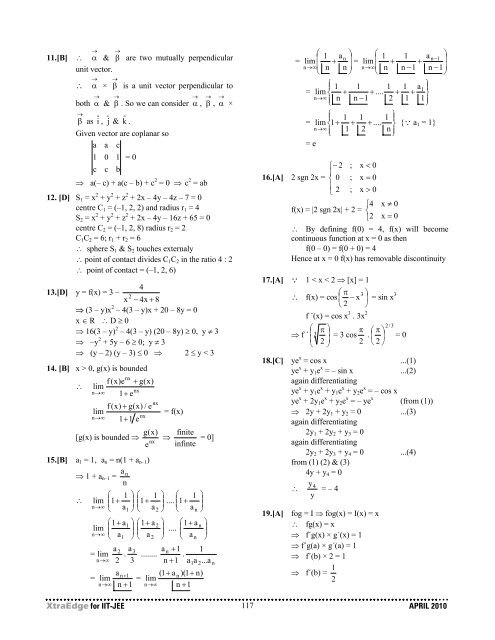Solution - Career Point
Solution - Career Point
Solution - Career Point
You also want an ePaper? Increase the reach of your titles
YUMPU automatically turns print PDFs into web optimized ePapers that Google loves.
11.[B]→ →∴ α & β are two mutually perpendicularunit vector.→ →∴ α × β is a unit vector perpendicular toboth → α & → β . So we can consider → α , → β , → α ×→β as î , ĵ & kˆ .Given vector are coplanar soa a c1 0 1 = 0c c b⇒ a(– c) + a(c – b) + c 2 = 0 ⇒ c 2 = ab12. [D] S 1 = x 2 + y 2 + z 2 + 2x – 4y – 4z – 7 = 0centre C 1 = (–1, 2, 2) and radius r 1 = 4S 2 = x 2 + y 2 + z 2 + 2x – 4y – 16z + 65 = 0centre C 2 = (–1, 2, 8) radius r 2 = 2C 1 C 2 = 6; r 1 + r 2 = 6∴ sphere S 1 & S 2 touches externaly∴ point of contact divides C 1 C 2 in the ratio 4 : 2∴ point of contact = (–1, 2, 6)413.[D] y = f(x) = 3 –2x − 4x + 8⇒ (3 – y)x 2 – 4(3 – y)x + 20 – 8y = 0x ∈ R ∴ D ≥ 0⇒ 16(3 – y) 2 – 4(3 – y) (20 – 8y) ≥ 0, y ≠ 3⇒ –y 2 + 5y – 6 ≥ 0; y ≠ 3⇒ (y – 2) (y – 3) ≤ 0 ⇒ 2 ≤ y < 314. [B] x > 0, g(x) is boundednxf (x)e + g(x)∴ limn→∞nx1+enxf (x) + g(x) / elim= f(x)n→∞nx1+1 e[g(x) is bounded ⇒15.[B] a 1 = 1, a n = n(1 + a n–1 )a ng(x)nxefinite⇒ = 0] infinte⇒ 1 + a n–1 =n⎛ 1 ⎞ ⎛ 1 ⎞ ⎛ 1∴ limn→∞⎜1+ ⎟⎝ a⎜1 + ⎟ ....1 ⎠ ⎝ a⎜1+2 ⎠ ⎝ a nlim ⎛ 1+an→∞⎟ ⎞⎜1⎛ 1+a ⎞⎝ a⎜2⎛ 1+a⎟ ....1 ⎠ ⎝ a⎜2 ⎠ ⎝ a n= lim a 2 a. 3 a........ n + 1 1 .n→∞2 3 n + 1 a1a2...a na n+1 (1 + a n )(1 + n)= lim = limn →∞ n + 1 n →∞ n + 1⎞⎟⎠n⎞⎟⎠⎛ ⎞= ⎜ 1 a ⎛nlim + ⎟ = ⎜ 1 1 a n−1lim + +n→∞⎜n n ⎟ n ∞⎜n n −1n −⎝ ⎠ ⎝⎪⎧1 1 1 1 a ⎪⎫1= lim ⎨ + + .... + + ⎬n→∞n n −12 1 1⎪⎩⎪⎭⎪⎧1 1 1 ⎪⎫= lim ⎨1+ + + .... ⎬ {Q a 1 = 1}n→∞1 2 n⎪⎩⎪⎭= e⎧−2⎪16.[A] 2 sgn 2x = ⎨ 0⎪⎩ 2;;;→ 1x < 0x = 0x > 0⎧4x ≠ 0f(x) = |2 sgn 2x| + 2 = ⎨⎩2x = 0∴ By defining f(0) = 4, f(x) will becomecontinuous function at x = 0 as thenf(0 – 0) = f(0 + 0) = 4Hence at x = 0 f(x) has removable discontinuity17.[A] Q 1 < x < 2 ⇒ [x] = 1π 3⎛ ⎞∴ f(x) = cos ⎜ − x ⎟ = sin x 3⎝ 2 ⎠f ´(x) = cos x 3 . 3x 22/ 3⎛ ⎞⇒ f ´ ⎜π⎟π ⎛ π3 = 3 cos . ⎝ 2 ⎠ 2 2 ⎟ ⎞⎜ = 0⎝ ⎠18.[C] ye x = cos x ...(1)ye x + y 1 e x = – sin x ...(2)again differentiatingye x + y 1 e x + y 1 e x + y 2 e x = – cos xye x + 2y 1 e x + y 2 e x = – ye x (from (1))⇒ 2y + 2y 1 + y 2 = 0 ...(3)again differentiating2y 1 + 2y 2 + y 3 = 0again differentiating2y 2 + 2y 3 + y 4 = 0 ...(4)from (1) (2) & (3)4y + y 4 = 0y∴ 4 = – 4y19.[A] fog = I ⇒ fog(x) = I(x) = x∴ fg(x) = x⇒ f´g(x) × g´(x) = 1⇒ f´g(a) × g´(a) = 1⇒ f´(b) × 2 = 1⇒ f´(b) = 21⎞⎟⎟⎠XtraEdge for IIT-JEE 117APRIL 2010
















